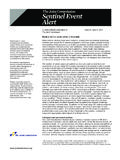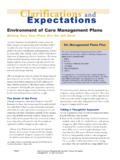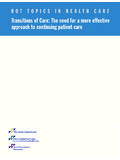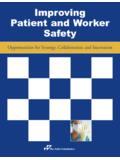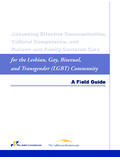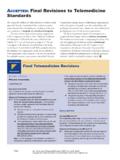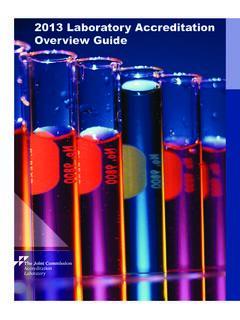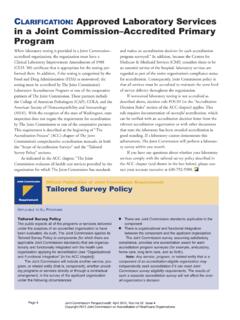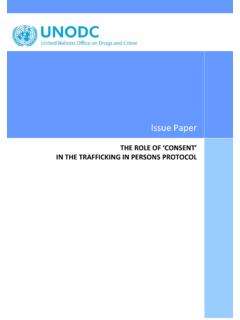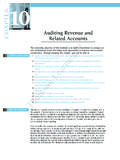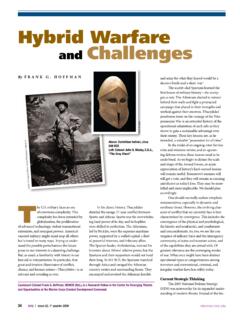Transcription of Provision of Care, Treatment, and Services standards for ...
1 2019 The joint commission A complimentary publication of The joint commission Is sue 24, August 21, 2019 Provision of Care, Treatment, and Services standards for maternal safety Effective July 1, 2020, 13 new elements of performance (EPs) will be applicable to joint commission -accredited hospitals. These new requirements are within the Provision of Care, Treatment, and Services (PC) chapter at and and are designed to improve the quality and safety of care provided to women during all stages of pregnancy and postpartum. The United States ranks 65th among industrialized nations in terms of maternal Because of worsening maternal morbidity and mortality, The joint commission evaluated expert literature to determine what areas held the most potential impact. The literature review revealed that prevention, early recognition, and timely treatment for maternal hemorrhage and severe hypertension/preeclampsia had the highest impact in states working on decreasing maternal complications.
2 This approach was supported by a technical advisory panel assembled by The joint commission , resulting in the development of EPs that focus on these complications. Engagement with stakeholders, customers, and experts In addition to an extensive literature review and public field review, The joint commission obtained expert guidance from the following groups: Technical Advisory Panel (TAP) of subject matter experts from various health care and academic organizations and professional associations from the maternal health field. standards Review Panel (SRP) comprised of clinicians and administrators who provided a boots on the ground point of view and insights into the practical application of the proposed standards . The prepublication version of the maternal safety standards will be available online until June 30, 2020. After July 1, 2020, please access the new requirements in the E-dition or standards manual.
3 _____ 1. Centers for Disease Control and Prevention. Reproductive Health, Pregnancy Mortality Surveillance System webpage. Page last reviewed: June 4, 2019. Accessed Aug. 20, for joint commission -accredited organizations and interested health care professionals, R3 Report provides the rationale and references that The joint commission employs in the development of new requirements. While the standards manuals also may provide a rationale, R3 Report goes into more depth, providing a rationale statement for each element of performance (EP). The references provide the evidence that supports the requirement. R3 Report may be reproduced if credited to The joint commission . Sign up for email delivery. 2019 The joint commission issue 24, Aug. 21, 2019 Page | 2 Provision of Care, Treatment, and Services standards for maternal safety Provision of Care, Treatment, and Services chapter Standard : Reduce the likelihood of harm related to maternal hemorrhage.
4 Requirement EP 1: Complete an assessment using an evidence-based tool for determining maternal hemorrhage risk on admission to labor and delivery and on admission to postpartum. (See also , EPs 1 and 2; , EP 3; , EP 2) Rationale Assessing and discussing patients risks for hemorrhage allows the team to identify higher-risk patients and be prepared. The risk of hemorrhage may change during a patient s stay depending on the clinical situation. Reference Harvey CJ. Evidence-Based Strategies for Maternal Stabilization and Rescue in Obstetric Hemorrhage. Advanced Critical Care. 2018;3(29):284-94. Requirement EP 2: Develop written evidence-based procedures for stage-based management of pregnant and postpartum patients who experience maternal hemorrhage that includes the following: The use of an evidence-based tool that includes an algorithm for identification and treatment of hemorrhage The use of an evidence-based set of emergency response medication(s) that are immediately available on the obstetric unit Required response team members and their roles in the event of severe hemorrhage How the response team and procedures are activated Blood bank plan and response for emergency release of blood products and how to initiate the organization s massive transfusion procedures Guidance on when to consult additional experts and consider transfer to a higher level of care Guidance on how to communicate with patients and families during and after the event Criteria for when a team debrief is required immediately after a case of severe hemorrhage Note.
5 The written procedures should be developed by a multidisciplinary team that includes representation from obstetrics, anesthesiology, nursing, laboratory, and blood bank. Rationale Having defined procedures to manage patients experiencing severe hemorrhage is integral to ensuring that everyone caring for a patient functions well as a team so delays in critical processes are minimized. Communication between team members during an emergency is a key factor for success. It is important for an organization to standardize the language team members will use to identify patients with severe hemorrhage and trigger a predetermined response from staff. Post-emergency debriefs are valuable for summarizing how well the team followed procedures and to determine if there are opportunities for improvement. Reference Committee on Practice, Bulletins-Obstetrics. Practice Bulletin No. 183: Postpartum Hemorrhage. Obstetrics & Gynecology.
6 2017;130(4):e168-e186. Kogutt BK and Vaught AJ. Postpartum Hemorrhage: Blood Product Management and Massive Transfusion. Seminars in Perinatology. 2019;43(1):44-50. American College of Obstetricians and Gynecologists. Preparing for Clinical Emergencies in Obstetrics and Gynecology. ACOG Committee Opinion No. 590. Obstetrics & Gynecology. 2014;123:722-725. World Health Organization. WHO Recommendations for the Prevention and Treatment of Postpartum Hemorrhage. Geneva, Switzerland: World Health Organization. 2012. Requirement EP 3: Each obstetric unit has a standardized, secured, dedicated hemorrhage supply kit that must be stocked per the organization s defined process and, at a minimum, contains the following: Emergency hemorrhage supplies as determined by the organization The organization s approved procedures for severe hemorrhage response 2019 The joint commission issue 24, Aug. 21, 2019 Page | 3 Provision of Care, Treatment, and Services standards for maternal safety Rationale Having all supplies to treat hemorrhage in one place is essential to minimizing delays in treatment.
7 Using defined processes during emergencies has been shown to improve adherence to recommended processes of care. Each organization should complete an assessment to determine the number of kits needed and the location to store them for easy access. Reference Agarwala AV, et al. Bringing Perioperative Emergency Manuals to Your Institution: A How To From Concept to Implementation in 10 Steps. The joint commission Journal on Quality and Patient Safety. 2019;45(3):170-179. Bereknyei MS, et al. Use of an Emergency Manual During an Intraoperative Cardiac Arrest by an Interprofessional Team: A Positive-Exemplar Case Study of a New Patient Safety Tool. The joint commission Journal on Quality and Patient Safety. 2018;44(8):477-484. World Health Organization. WHO Recommendations for the Prevention and Treatment of Postpartum Hemorrhage. Geneva, Switzerland: World Health Organization. 2012. Requirement EP 4: Provide role-specific education to all staff and providers who treat pregnant and postpartum patients about the organization s hemorrhage procedure.
8 At a minimum, education occurs at orientation, whenever changes to the processes or procedures occur, or every two years. Rationale For the care team to function optimally in a true emergency, it is essential that all members know the procedures they should follow in the event of hemorrhage. Although not required, in situ simulations that allow staff to practice organizational procedures in actual clinical settings are encouraged. Reference Committee on Practice, Bulletins-Obstetrics. Practice Bulletin No. 183: Postpartum Hemorrhage. Obstetrics & Gynecology. 2017;130(4):e168-e186. American College of Obstetricians and Gynecologists. Preparing for Clinical Emergencies in Obstetrics and Gynecology. ACOG Committee Opinion No. 590. Obstetrics & Gynecology. 2014;123:722-725. Requirement EP 5: Conduct drills at least annually to determine system issues as part of on-going quality improvement efforts.
9 Drills include representation from each discipline identified in the organization s hemorrhage response procedure and include a team debrief after the drill. Rationale Multidisciplinary drills give an organization the opportunity to practice skills and identify system issues ( , unwillingness of the blood bank to release blood products despite authorization for this in the procedure) in a controlled environment. It is crucial to have members from as many disciplines identified in the organization s response procedure as possible available during drills to be able to test each level of the emergency and identify areas of improvement. This is crucial for identifying weaknesses in the response system and to identify opportunities for improvement. Organizations should assess their level of proficiency to determine the frequency drills should be performed; organizations that have reached a high level of mastery may need less frequent drills.
10 Reference American College of Obstetricians and Gynecologists. Preparing for Clinical Emergencies in Obstetrics and Gynecology. ACOG Committee Opinion No. 590. Obstetrics & Gynecology. 2014;123:722-725. Kyryabina E, et al. What is the Value of Health Emergency Preparedness Exercises? A Scoping Review Study. International Journal of Disaster Risk Reduction. 2017;21:274-283. Lee A, et al. Intrapartum Maternal Cardiac Arrest: A Simulation for Multidisciplinary Providers. MedEdPORTAL. 2018;14:1-8. Requirement EP 6: Review hemorrhage cases that meet criteria established by the organization to evaluate the effectiveness of the care, treatment, and Services provided by the hemorrhage response team during the event. Rationale Continuous feedback loops are imperative for organizations to find errors and improve skills to ensure that patients are receiving the highest level of care. Root cause analysis, apparent-cause analysis, or similar tools to review the care in a rigorous, psychologically 2019 The joint commission issue 24, Aug.

